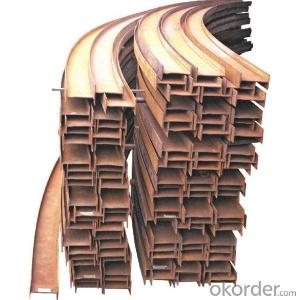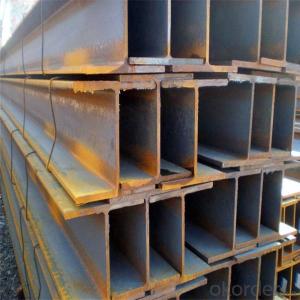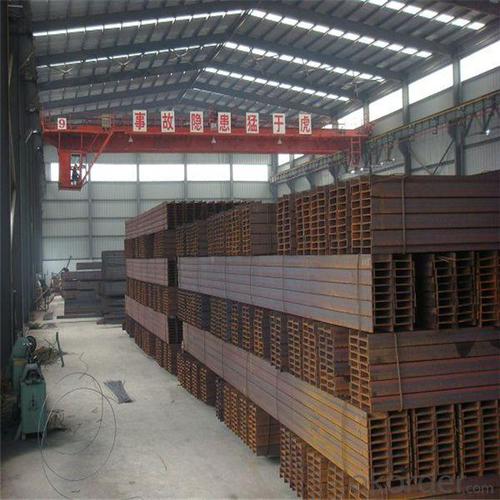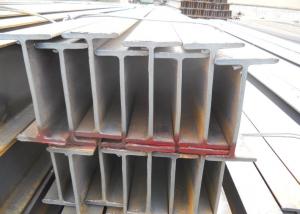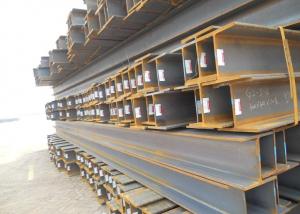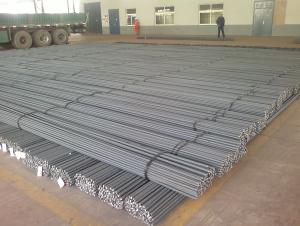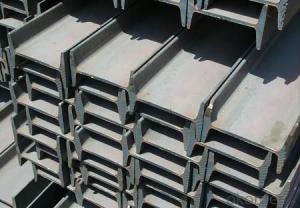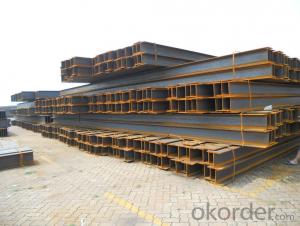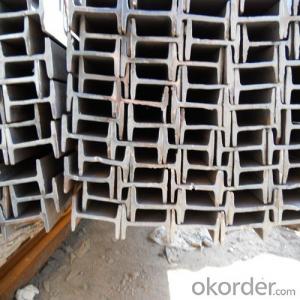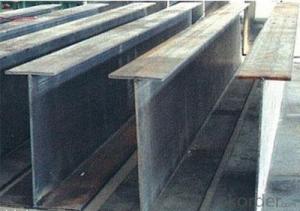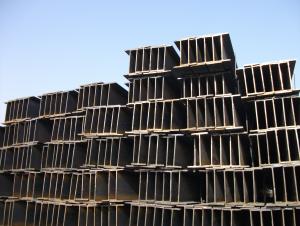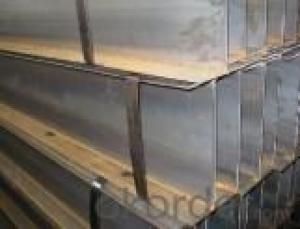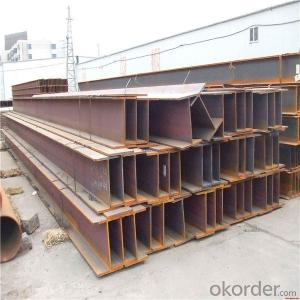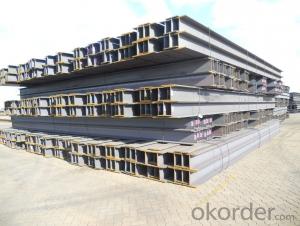Jis Standard H Steel Beams in Stock at Good Price
- Loading Port:
- Dalian
- Payment Terms:
- TT OR LC
- Min Order Qty:
- 100 m.t
- Supply Capability:
- 150000 m.t/month
OKorder Service Pledge
OKorder Financial Service
You Might Also Like
Specification
Quick Detail
Standard: | ASTM, GB, JIS | Grade: | Q235Q345ss400ss490 | Dimensions: | HM100*100*6*--8#428*407*20*35 |
Place of Origin: | Hebei, China (Mainland) | Brand Name: | JINXI | Type: | Alloy Structural Steel |
Application: | roof beam | Shape: | Beams | price: | competitive |
We can provide qualify goods,competitive price and speedy delivery.
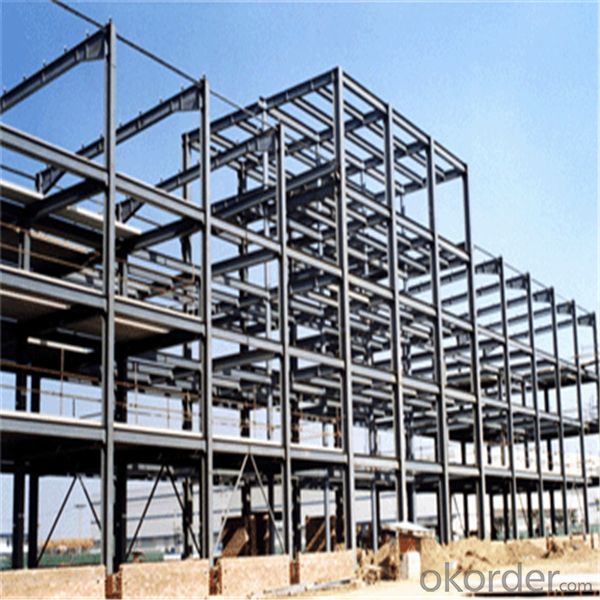
Products Description
H Type Steel Size and Theoretical Weight | |||||
Size | Theoretical Weight | Size | Theoretical Weight | Size | Theoretical Weight |
|
|
|
|
|
|
(mm) | (kg/m) | (mm) | (kg/m) | (mm) | (kg/m) |
100*50*5*7 | 9.3 | 250*125*6*9 | 29 | 446*199*8*12 | 65.1 |
100*100*6*8 | 16.9 | 250*250*9*14 | 71.8 | 450*200*9*14 | 74.9 |
125*60*6*8 | 13.1 | 294*200*8*12 | 55.8 | 482*300*11*15 | 110.8 |
125*125*6.5*9 | 23.6 | 298*149*5.5*8 | 32 | 488*300*11*18 | 124.9 |
148*100*6*9 | 31.1 | 340*250*9*14 | 36.7 | 496*199*9*14 | 77.9 |
150*75*5*7 | 14 | 300*150*6.5*9 | 93 | 500*200*10*16 | 88.1 |
150*150*7*10 | 20.7 | 300*300*10*15 | 78.1 | 582*300*12*17 | 132.8 |
175*90*5*8 | 18 | 346*174*6*9 | 41.2 | 588*300*12*20 | 147 |
175*175*7.5*11 | 40.4 | 350*175*7*11 | 49.4 | 596*199*10*15 | 92.4 |
194*150*6*9 | 29.9 | 350*350*12*19 | 134.9 | 600*200*11*17 | 103.4 |
198*99*4.5*7 | 17.8 | 390*300*10*16 | 104.6 | 700*300*13*24 | 181.8 |
200*100*5.5*8 | 20.9 | 396*199*7*11 | 56.1 | 800*300*14*26 | 206.8 |
200*200*8*12 | 49.9 | 400*200*8*13 | 65.4 | 900*300*16*28 | 240.1 |
244*175*7*11 | 43.6 | 400*400*13*21 | 171.7 |
|
|
248*124*5*8 | 25.1 | 440*300*11*18 | 120.8 |
|
|
Length=6------12meters | |||||
Packaging & Delivery
Packaging Details: | Packed with waterproof paper and steel banding. |
Delivery Detail: | 15-25 |
FAQ
1. How can I get some samples?
We are honored to offer you samples. New clients are expected to pay for the courier cost. The samples are free for you.
2 Do you have any certificates?
Our products passed inspection of SGS, FDA, and CE Quality is priority! Every worker keeps the QC from the very beginning to the very end, Quality control department especially responsible for quality checking in each process.
3 Can your factory print or emboss my logo on the goods?
Yes, we can print or emboss the logo on the goods or their packing box.
4 What information should I let you know if I want to get a quotation?
1) The specification of products (length x width x thickness);
2) The temper and alloy.
3) The final product you will use to be made
4 It will be better if you can show us the pictures or design sketch. Samples will be best for clarifying. If not, we will recommend relevant products with details for reference.We usually produce goods based on customers
Samples or based on customers’ picture, logo, sizes etc.
- Q: What are the cost implications of using steel H-beams?
- The cost implications of using steel H-beams can vary depending on multiple factors. Initially, the upfront cost of steel H-beams may be higher compared to other building materials. However, steel H-beams provide numerous long-term cost benefits. They are incredibly durable and resistant to wear and tear, reducing the need for frequent repairs or replacements. Additionally, steel H-beams are highly versatile and can support large loads, allowing for efficient structural designs and potentially reducing the overall construction costs. Furthermore, steel is a sustainable and recyclable material, which can contribute to cost savings in terms of waste management. Overall, while the initial investment may be higher, the long-term cost savings and advantages offered by steel H-beams make them a favorable choice for many construction projects.
- Q: Can steel H-beams be used for long-span structures?
- Long-span structures can indeed utilize steel H-beams. These beams are widely employed in construction owing to their exceptional strength-to-weight ratio and versatility. They possess the capability to span considerable distances without necessitating supplementary support columns or beams. The H-shaped design ensures structural stability and even distribution of the load, rendering them suitable for long-span structures such as bridges, high-rise buildings, and industrial facilities. Moreover, steel H-beams can be easily fabricated and interconnected, facilitating efficient construction and customization to meet specific design requirements. Overall, steel H-beams are a highly favored option for long-span structures due to their robustness, endurance, and cost-effectiveness.
- Q: What is the maximum load capacity of steel H-beams?
- The maximum load capacity of steel H-beams can vary depending on various factors such as the size, shape, and grade of the beam, as well as the span and support conditions of the specific application. Steel H-beams are designed to withstand heavy loads and are commonly used in construction and structural engineering projects. It is essential to consult engineering professionals or refer to structural design guidelines and load tables provided by manufacturers to determine the specific maximum load capacity for a given steel H-beam.
- Q: Can Steel H-Beams be used in museum or gallery construction?
- Yes, Steel H-Beams can be used in museum or gallery construction. Steel H-Beams are commonly used in construction due to their strength and durability. They provide structural support and can withstand heavy loads, making them suitable for large and open spaces like museums and galleries. Additionally, Steel H-Beams are versatile and can be fabricated to meet specific design requirements, allowing for unique architectural features. Their fire resistance properties also make them a safe choice for such buildings. Overall, Steel H-Beams are a popular choice in construction, including museum and gallery projects, due to their strength, versatility, and safety features.
- Q: How do steel H-beams perform in structures with heavy machinery and equipment?
- Steel H-beams are known for their exceptional strength and load-bearing capacity, making them highly suitable for structures with heavy machinery and equipment. Due to their structural stability and resistance to bending under heavy loads, H-beams provide reliable support and ensure the integrity of the structure. They effectively distribute the weight and stress across the beam, minimizing the risk of structural failure and ensuring the safety of the machinery and equipment being used.
- Q: Are steel H-beams suitable for structures with long cantilevers?
- Structures with long cantilevers can indeed benefit from the use of steel H-beams. H-beams are renowned for their impressive strength-to-weight ratio, making them an optimal choice for supporting heavy loads across extensive distances. They possess exceptional structural stability and can withstand considerable bending moments and shear forces, which are crucial prerequisites for cantilever structures. The design of H-beams ensures the even distribution of weight and load throughout their structure, thereby guaranteeing the stability and security of the cantilevered section. The deep profile of H-beams facilitates efficient weight distribution, thereby minimizing the risk of structural failure or deflection. Furthermore, steel H-beams possess remarkable durability and corrosion resistance, rendering them suitable for outdoor or exposed applications. They can endure extreme weather conditions and maintain their structural integrity over time. Moreover, steel is an immensely versatile material that can be easily fabricated and tailored to meet specific project requirements. H-beams can be cut, welded, and joined to form various shapes and sizes, accommodating the precise dimensions and load-bearing needs of the cantilever structure. In conclusion, steel H-beams provide the essential strength, stability, and durability necessary for structures featuring long cantilevers.
- Q: Can steel H-beams be used in school or educational facility construction?
- Yes, steel H-beams can be used in school or educational facility construction. Steel H-beams are commonly used in construction due to their structural strength, durability, and ability to withstand heavy loads. They provide stability and support to the building's framework, making them suitable for constructing large educational facilities. Additionally, steel H-beams offer flexibility in design and can be easily integrated into various architectural styles, allowing for creative and modern educational spaces.
- Q: What are the different types of steel H-beam connections for high-temperature environments?
- To ensure structural integrity and durability in high-temperature environments, different types of steel H-beam connections can be utilized. These connections are specifically designed to withstand thermal expansion, contraction, and other temperature-related stresses. Some commonly used steel H-beam connections for high-temperature environments include: 1. Welded Connections: Welding is a widely employed method for connecting steel H-beams in high-temperature environments. It involves the fusion of H-beam ends or flanges using heat and pressure. When executed properly, welded connections offer exceptional strength and stability. 2. Bolted Connections: Bolted connections involve the use of bolts, nuts, and washers to secure H-beam members together. In high-temperature environments, it is crucial to select bolts made from materials that can withstand elevated temperatures without losing strength or experiencing deformation. 3. Pinned Connections: Pinned connections utilize pins or dowels to connect H-beams. These connections allow for rotational movement between the members while maintaining axial alignment. Pinned connections are often utilized in high-temperature environments where accommodating thermal expansion and contraction is necessary. 4. Slotted Holes: In certain cases, slotted holes can be incorporated in the connection plates to facilitate thermal expansion and contraction. This design enables slight movement of the H-beams while maintaining connection integrity. Slotted holes provide flexibility and reduce stress concentrations resulting from temperature variations. 5. Expansion Joints: In high-temperature environments where significant thermal expansion is expected, incorporation of expansion joints in H-beam connections is recommended. Expansion joints consist of flexible elements that absorb movement caused by temperature changes, preventing excessive stress on the H-beams. 6. Thermal Insulation: In some instances, thermal insulation materials may be employed to minimize heat transfer between steel H-beam connections and the surrounding environment. This helps safeguard the connections from excessive temperatures and reduces the risk of structural failure. It is important to note that the appropriate selection of steel H-beam connections for high-temperature environments depends on various factors, including expected temperature range, load conditions, material properties, and design requirements. Consulting with a structural engineer or specialized professional is advisable to ensure proper selection and design of H-beam connections in high-temperature environments.
- Q: What are the different protective coatings available for steel H-beams?
- Steel H-beams have a variety of protective coatings available to enhance durability and prevent corrosion. These coatings are designed to withstand different environmental conditions and offer long-lasting protection. Some commonly used coatings for steel H-beams include: 1. Galvanizing: A widely used coating that involves applying a layer of zinc to create a protective barrier against rust, corrosion, moisture, chemicals, and abrasion. 2. Epoxy Coatings: These coatings provide high-level protection against chemicals, moisture, and UV rays. They are resistant to abrasion and can be applied in different thicknesses based on protection needs. Epoxy coatings are commonly used in industries like oil and gas, marine, and construction. 3. Powder Coating: This dry finishing process applies a layer of powdered resin onto the steel surface. After heating, the powder melts to form a protective layer. Powder coating offers excellent resistance to corrosion, chemicals, and UV rays. It also provides a wide range of color options, making it popular for architectural applications. 4. Paint: Applying a high-quality industrial paint acts as a barrier against moisture, chemicals, and UV rays. It is essential to use paint specifically formulated for steel and apply multiple coats for sufficient protection. 5. Metalizing: This process involves applying a layer of molten metal, like zinc or aluminum, to the steel surface. Metalizing provides excellent corrosion protection and can be applied in different thicknesses depending on the desired level of protection. It is commonly used in harsh environments such as marine and offshore applications. When selecting a protective coating for steel H-beams, factors like intended use, environmental conditions, and budget should be considered. Consulting with a professional or coating specialist can help determine the most suitable coating for specific requirements, ensuring optimal protection and longevity for the steel H-beams.
- Q: What are the different design codes and standards for steel H-beams?
- Some of the different design codes and standards for steel H-beams include the American Institute of Steel Construction (AISC) 360, Eurocode 3, British Standards (BS) 5950, and the Canadian Standards Association (CSA) S16. These codes and standards provide guidelines and specifications for the design, fabrication, and construction of steel H-beams, ensuring structural integrity and safety.
Send your message to us
Jis Standard H Steel Beams in Stock at Good Price
- Loading Port:
- Dalian
- Payment Terms:
- TT OR LC
- Min Order Qty:
- 100 m.t
- Supply Capability:
- 150000 m.t/month
OKorder Service Pledge
OKorder Financial Service
Similar products
Hot products
Hot Searches
Related keywords

